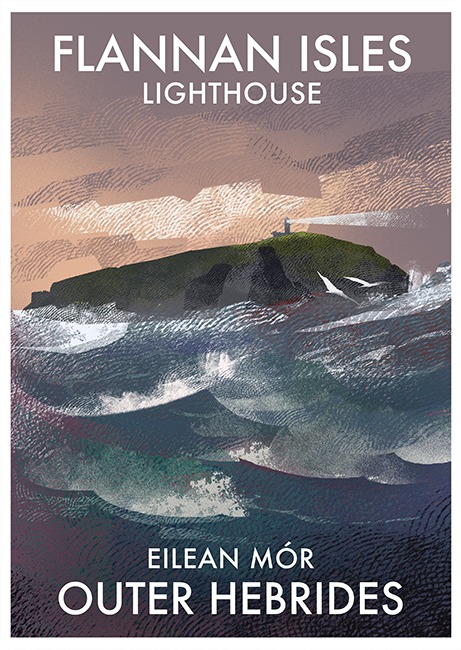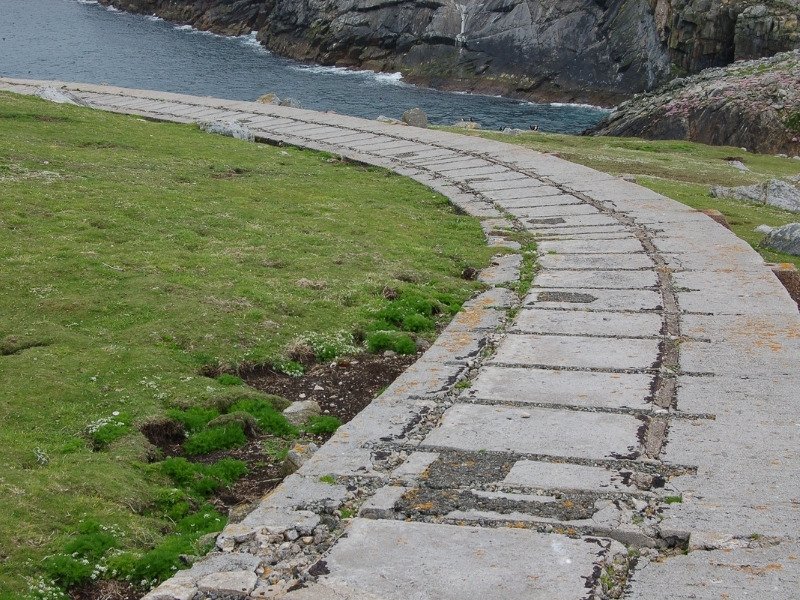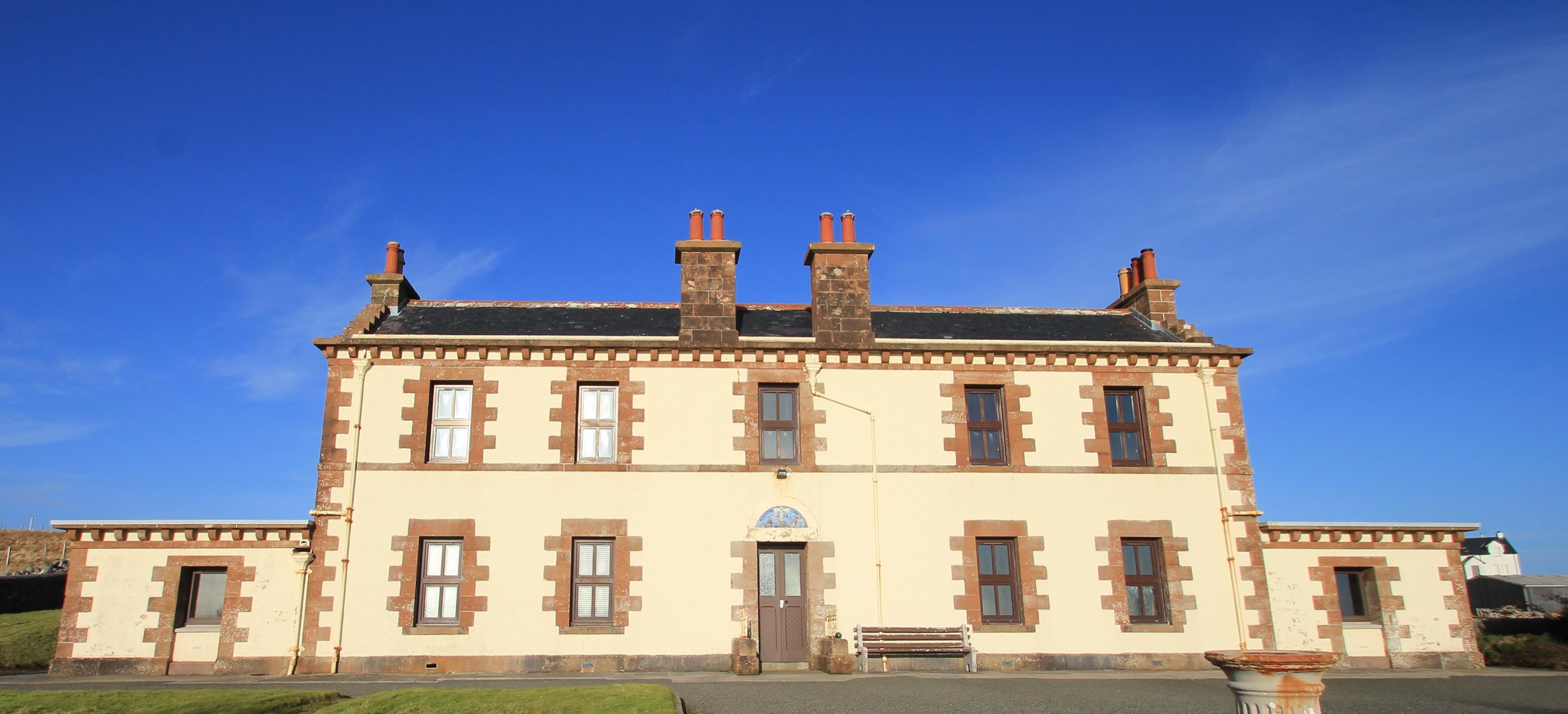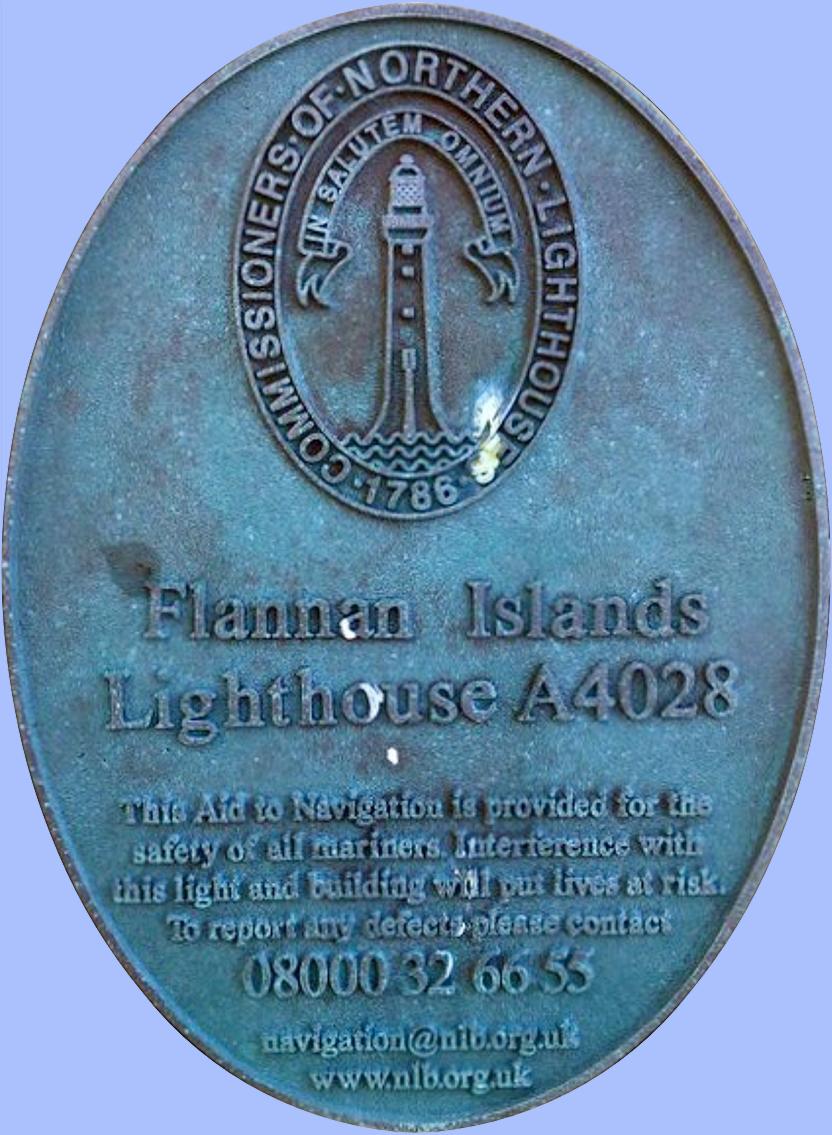
Place of the lighthouse
The Flannan Islands (Scottish Gaelic: Na h-Eileanan Flannach, pronounced [nə ˈhelanən ˈflˠ̪an̪ˠəx]) or alternatively the Seven Hunters are a small group of islands in the Outer Hebrides of Scotland, about 36 kilometer west of the Isle of Lewis . They may take their name from Saint Flannan, the seventh-century Irish preacher and abbot. The islands have been devoid of permanent residents since the automation of Flannan Isles Lighthouse in 1971.
Building of the Lighthouse
The 23 meter high lighthouse was built in 1899 by the contractor George Lawson of Rutherglen under the supervision of Northern Lighthouse Board (NLB) engineer David Alan Stevenson.
Construction, between 1895 and 1899, was undertaken by George Lawson of Rutherglen at a cost of £6,914. This amount included the construction of the moorings, stairs, railway tracks etc. All the building materials used had to be hoisted from supply boats onto the 150-foot (45 m) high cliffs, not an easy job in the ever-swirling Atlantic Ocean. A further £3,526 was spent on Breasclete's Shore Station on the Isle of Lewis. (see below)
A three-storey, one-storey, plastered round lighthouse with a flat roof serving as technical installations and storage and accommodation areas. This complex in the NLB house style (black dome and golden yellow colors) is located on the high, steep top of the island of Mòr. The whole is surrounded by a semi-high wall.
The base of the dome (2nd floor) is surrounded by a cantilevered walkway with a steel railing where the tower itself is colored golden yellow. A row of small glass portholes and doors are arranged in the rows. Narrower open cast iron platform surmounted by a lamp with diagonal astragals and spherical dome-shaped hood with weather vane.

A Railway on the Eilean Mòr
There is also a cable car-based railway on the island. The purpose of the rail lines was to make it easier to transport supplies for the Keepers and fuel for the Light (petroleum, at that time; the light used twenty barrels a year) from the moorings below the steep slopes.
This cable car-based railway was powered by a small steam engine in a shed next to the lighthouse. From the lighthouse a track descended west and then turned south. Roughly in the middle of the island, it split through a hand-operated switch which was humorously dubbed "Clapham Junction".
A branch continues its curvature to the east to head for the eastern landing site at the southeast corner of the island, forming a half circle. The other, slightly shorter branch to the west goes to the western landing site, located in a small cove on the south coast of the island. This railway is clearly visible on the first picture in the right column.
The last approaches to the jetties were extremely steep. The cable was guided around the bends by pulleys placed between the rails, and a row of posts outside the inner rail prevented it from straying too far if it jumped off the pulleys. The cargo was carried in a small four-wheeled bogie.


Warning systems (Light, Fog horn, Radar Beacon)
The lighthouse was originally equipped with a Hyper-radial Fresnel lens. The lighting was provided by Acetylene gas with a Dalén valve. The character is 2 flashes every thirty seconds with a range of 20 nautical miles. This is still in effect.
During the automation in 1971, the magnificent Hyper-radial lens was deliberately destroyed by the custodians on behalf of NLB headquarters. The lens was (perhaps) too big to be removed from the rock, so the glass was knocked out of the heavy brass panels. The copper was brought ashore and reportedly sold for scrap.
The lighthouse has now an 4th Order lens on a Pelangi PRL 600 gearless pedestal that rotates at 1 rpm. In 1998 the use of Acetylene gas ended and solar panels were installed for the power supply. The lamp itself is a 35 Watt Metal Halide lamp.



Additional information for lighthouses in general or as a reference
In 1925, the lighthouse was one of the first Scottish lights to communicate with the mainland via wireless communication.
Before this communication was established, a gamekeeper, Roderick MacKenzie, was appointed as an observer for which he received a payment of £8 per annum. MacKenzie's job was to see if the lighthouse was still functioning properly. He did so from the Gallan Head viewpoint on the Isle of Lewis. (approximately 36 kilometres.) In the event of malfunctions, he had to report this immediately, by telegram, to the NLB's head office in Edinburgh.
In the 1960s, the transportation system on the island was modernized. The track was removed, leaving the concrete bed of the rails as a roadway for a Quaud - a three-wheeled, rubber-tyred all-terrain vehicle powered by a 400cc four-stroke engine built by Aimers McLean of Galashiels. This vehicle had a shorter service life than the earlier railway. At the automation in 1971, a reinforced concrete helipad was built to allow for maintenance visits.
Flannan Isles Shore station
Lighthouses that were so remote, such as the Flannan Isle lighthouse, were referred to as a rock station. At this type of station it was normal for the lighthouse Keepers to live alone at the lighthouse and for their families to live on the mainland. The lighthouse Keepers were replaced by a fresh crew once every four weeks.
The former coastal station for the families of the Flannan Isles Keepers is located at Breasclete on the Isle of Lewis. This coastal station was built in 1899 at the same time as the lighthouse. It was designed by David Alan and Charles Stevenson. The location for Breascelete coastal station was chosen for its proximity to Loch Roag, an estuary, which provided a safe anchorage and shelter for the lighthouse tender when taking on board or landing the lighthouse keepers for the lighthouse relief.
A total of four families lived in the self-contained apartments, each with its own entrance. The first four families to live on the Flannan Isles shore station were those of Principal Lighthouse Keeper (PLK) James Ducat and the Assistant Lighthouse Keepers (ALK's) William Ross, Thomas Marshall, and Joseph Moore. The Occasional Keeper, Donald MacArthur lived nearby.
James Ducat and Thomas Marshall were living at the property with their families when they disappeared from Flannan Isle in December 1900. Keeper Ducat left a widow and four children and Keepers Marshall and MacArthur left a widow and two children.
After the Flannan Isles Lighthouse was automated in 1971, the Breasclete property was abandoned by the lighthouse Keepers. The property was acquired by Hebridean Housing Partnership in 2006. They rented out the apartments for social housing.
In November 2015 it was decided to sell the monumental building. After a local campaign, the local community took over the building in 2019. The building, known locally as An Taigh Mor, was purchased as a community buyout. They received help from subsidies and financing from the municipality. In the same year, 2019, The Princess Royal visited the house and unveiled a new memorial to the custodians.



The disappearance of the Lighthouse Keepers, December 1900

The three disappeared Lighthouse Keepers were:
- James Ducat, Middle (Principal Keeper)
- Thomas Marshall, Left, (2nd Assistant Goalkeeper) and
- Donald McArthur, Right, Occasional Keeper serving for
- William Ross, 1st Assistant who was on sick leave.
The steamer Anchoror was the first to notice that something was wrong. On December 15, 1900, it had noted in its logbook that the light of the lighthouse on Eilean Mòr was not working. This was especially alarming as the weather conditions were extremely bad. It was only after docking in Leith three days later, that the lighthouse's non-functioning was reported to the Northern Lighthouse Board.
The disappearance of the lighthouse keepers was only discovered during a routine visit to relieve the keeper(s) and replenish supplies, which was scheduled for December 20. Due to bad weather, the lighthouse tender HESPERUS (I) did not arrive until Boxing Day (26 December) at 12 noon.
Normal usage dictates that the on-duty lighthouse keepers welcome their relief party as soon as they arrive, but no one was waiting to welcome the Hesperus. Captain Jim Harvey blew his horn and fired a flare to alert the three lighthouse keepers. He waited, hoping to see the men coming toward them, but there was no response. There was also no flag hanging from the flagpole and no provision boxes were present on the quay as was usual.
Joseph Moore, one of the relief Keepers, was sent to the island to investigate further. He made his way up the hundred and sixty steep steps that led to the lighthouse. He found the front door and gate to the compound closed, but not locked. He went inside and saw that all the beds were unmade and that the wall clock had stopped. The dining table was set for a meal and one of the chairs had fallen over.
Captain Harvey, commanding officer of the HESPERUS, upon arrival at the lighthouse on the Eilean Mòr on the afternoon of December 26, 1900, reported that there was no sign of life on the island and no response to the tender firing a level of fire.
The relieving Keeper, Joseph Moore, wrote the next letter to the Commissioners of the NLB:
Sirs,
It was with deep regret I wish you to learn the very sad affair that has taken place here during the past fortnight; namely the disappearance of my two fellow lightkeepers Mr Ducat and Mr Marshall, together with the Occasional Keeper, Donald McArthur from off this Island.
As you are aware, the relief was made on the 26th. That day, as on other relief days, we came to anchorage under Flannan Islands, and not seeing the Lighthouse Flag flying, we thought they did not perceive us coming. The steamer's horn was sounded several times, still no reply. At last Captain Harvie deemed it prudent to lower a boat and land a man if it was possible. I was the first to land leaving Mr McCormack and his men in the boat till I should return from the lighthouse.
I went up, and on coming to the entrance gate I found it closed. I made for entrance door leading to the kitchen and store room, found it also closed and the door inside that, but the kitchen door itself was open. On entering the kitchen I looked at the fireplace and saw that the fire was not lighted for some days. I then entered the rooms in succession, found the beds empty just as they left them in the early morning.
I did not take time to search further, for I only too well knew something serious had occurred. I darted out and made for the landing. When I reached there I informed Mr McCormack that the place was deserted. He with some of the men came up second time, so as to make sure, but unfortunately the first impression was only too true. Mr McCormack and myself proceeded to the lightroom where everything was in proper order. The lamp was cleaned. The fountain full. Blinds on the windows etc.
We left and proceeded on board the steamer. On arrival Captain Harvie ordered me back again to the island accompanied with Mr McDonald (Buoymaster), A Campbell and A Lamont who were to do duty with me till timely aid should arrive. We went ashore and proceeded up to the lightroom and lighted the light in the proper time that night and every night since. The following day we traversed the Island from end to end but still nothing to be seen to convince us how it happened. Nothing appears touched at East landing to show that they were taken from there. Ropes are all in their respective places in the shelter, just as they were left after the relief on the 7th.
On West side it is somewhat different. We had an old box halfway up the railway for holding West landing mooring ropes and tackle, and it has gone. Some of the ropes it appears, got washed out of it, they lie strewn on the rocks near the crane. The crane itself is safe.
The iron railings along the passage connecting railway with footpath to landing and started from their foundation and broken in several places, also railing round crane, and handrail for making mooring rope fast for boat, is entirely carried away. Now there is nothing to give us an indication that it was there the poor men lost their lives, only that Mr Marshall has his seaboots on and oilskins, also Mr Ducat has his seaboots on. He had no oilskin, only an old waterproof coat, and that is away. Donald McArthur has his wearing coat left behind him which shows, as far as I know, that he went out in shirt sleeves. He never used any other coat on previous occasions, only the one I am referring to.
Mr J. Moore,
Assistant Lightkeeper,
Flannan Islands Lighthouse
28 December 1900
The men remaining on the island scoured every corner for clues as to the fate of the keepers. At the east landing everything was intact, but the west landing provided considerable evidence of damage caused by recent storms. A box at 33 meters above sea level had been broken and its contents strewn about; iron railings were bent over, the iron railway by the path was wrenched out of its concrete, and a rock weighing more than a ton had been displaced above that.
On top of the cliff at more than 60 meters above sea level, turf had been ripped away as far as 10 meters from the cliff edge. Remarkably, the last written entries in the log were dated December 13. Details of December 14 and the time of the lights going out on December 15, along with barometric and thermometer readings and wind conditions, taken at 9:00 a.m. on the morning of December 15, were noted on the slate for later transfer to the logbook
Everything was in order, the lamp ready to be lit, and it was clear that the work of the morning of the 15th had been completed, indicating that the men had disappeared by Saturday afternoon, December 15th.
Moore's conclusion was that the lighthouse keepers left the lighthouse for some reason, probably to secure some equipment and/or to assess the damage done to one of the landing sites. It is believed that a large wave grabbed the people and swept them into the sea.
The Hesperus returned to the shore station at Breasclete. Captain Harvey sent the following telegram to the Northern Lighthouse Board on 26 December 1900:
"A dreadful accident has happened at Flannans. The three Keepers, Ducat, Marshall and the occasional have disappeared from the island. On our arrival there this afternoon no sign of life was to be seen on the Island. Fired a rocket but, as no response was made, managed to land Moore, who went up to the Station but found no Keepers there.
The clocks were stopped and other signs indicated that the accident must have happened about a week ago. Poor fellows they must been blown over the cliffs or drowned trying to secure a crane or something like that. Night coming on, we could not wait to make something as to their fate.
I have left Moore, MacDonald, Buoymaster and two Seamen on the island to keep the light burning until you make other arrangements. Will not return to Oban until I hear from you. I have repeated this wire to Muirhead in case you are not at home. I will remain at the telegraph office tonight until it closes, if you wish to wire me."
Master, HESPERUSThis island lighthouse is situated 21 miles W of the Isle of Lewis, among the Atlantic Outliers (also known as the Seven Hunters or Seven Haly Isles. This lighthouse is one of the four in Scottish waters over 10 miles from land, the others being Sule Skerry (HX62SW 1), Dubh Artach (NM10SW 1) and Bell Rock (NO72NE 1). It is situated on the summit of Eilean Mor, the largest island of the group, and comprises a tower 23m with a keepers' house (NA74NW 6.01) on the inland side. Access was formerly gained from landing-places on both the E and W sides of the islands, each of these having a lengthy flight of rock-cut steps up the high cliffs, and a small tramway. Boat landing at these locations was always difficult. The lighthouse was built by DA Stevenson in 1895-9, being first lit on 7 December 1899. It was converted to automatic working on 28 September 1971, a Dalen gas light being fitted. A helicopter landing pad was built adjacent to the lighthouse at about this date. The lighthouse is best known for the disappearance of three keepers (presumably through a heavy wave) in 1900, an incident which has been the subject of artistic representation, most recently in Sir Peter Maxwell Davies' chamber opera The Lighthouse. Otherwise, the lighthouse is noteworthy for the successive installation of an experimental wireless telegraph link (in 1907) and a radio telephone (by 1925). Information from RCAHMS (RJCM), 23 June 2008. R W Munro 1979; [Admiralty] 1980; K Allardyce and E M Hood 1986; S Krauskopf 2001.



 Update: 01-03-2025
Update: 01-03-2025






